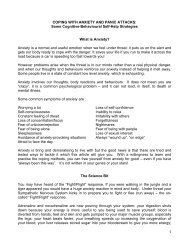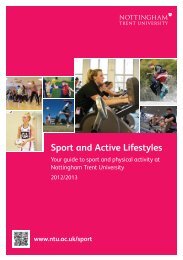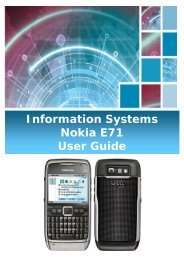Nottingham Trent University Icebreakers Guide
Nottingham Trent University Icebreakers Guide
Nottingham Trent University Icebreakers Guide
Create successful ePaper yourself
Turn your PDF publications into a flip-book with our unique Google optimized e-Paper software.
2. Who will I be working with?<br />
3. Who will I be living with?<br />
Ice-breakers are one of the tools teaching staff can use to help students to answer<br />
the first two questions. It would be overstating the case to claim that ice-breakers<br />
are all that is required to enable students to develop friendships, but they are one<br />
technique teaching staff can use to engender an environment in which such<br />
friendships can blossom.<br />
When are ice-breakers useful?<br />
<strong>Icebreakers</strong> are potentially at their most useful with groups of students coming<br />
together for the first time. The most obvious use is during the Welcome Week, but<br />
there are also benefits in facilitating ice-breakers at the start of subsequent years<br />
and at the start of group projects. A minority of students won’t have learnt the<br />
names of their peers by the end of the first year; perhaps because it is embarrassing<br />
to ask other students their names once the initial induction window has closed. The<br />
occasional use of ice-breakers throughout the year may help such students to feel<br />
less isolated from their peers.<br />
Tips for facilitating ice-breakers<br />
“I’m sorry, but it says here that we’ve got to do an ice-breaker now.”<br />
Ice-breakers are relatively-active, energetic activities. Lecturers need to congruently<br />
communicate this in the way they facilitate the activity. If you hate the idea of doing<br />
ice-breakers, then it’s probably worth swapping this particular task with a colleague.<br />
Programme teams should try to ensure that they are using a range of different<br />
icebreakers with their student groups. Even the best icebreaker starts to grate if<br />
overused. There are twenty four ice-breakers in this guide and an internet search<br />
will quickly turn up hundreds of activities for use.<br />
Try to link the ice-breakers into the course. This does not necessarily mean<br />
cataloguing the learning outcomes for each activity, but if the relevance of the icebreakers<br />
can be introduced to the group, and links made to future learning, students<br />
are likely to engage more fully.<br />
Rehearse the ice-breaker. Most of the ice-breakers are extremely easy to facilitate,<br />
being essentially structured discussions, however some are more complex and these<br />
will require some preparation. If you would like to discuss how each ice-breaker<br />
works, please feel free to contact Ed Foster, ext 88203<br />
Health & Safety<br />
There is an element of risk with some of these activities (there’s marginally more<br />
activity than asking students to sit at their desks), but it’s very minimal. You’ll need<br />
to look at the instructions and think through any issues raised. Please don’t hesitate<br />
to contact Ed Foster if you have any concerns.<br />
NTU <strong>Icebreakers</strong> <strong>Guide</strong> 3
















